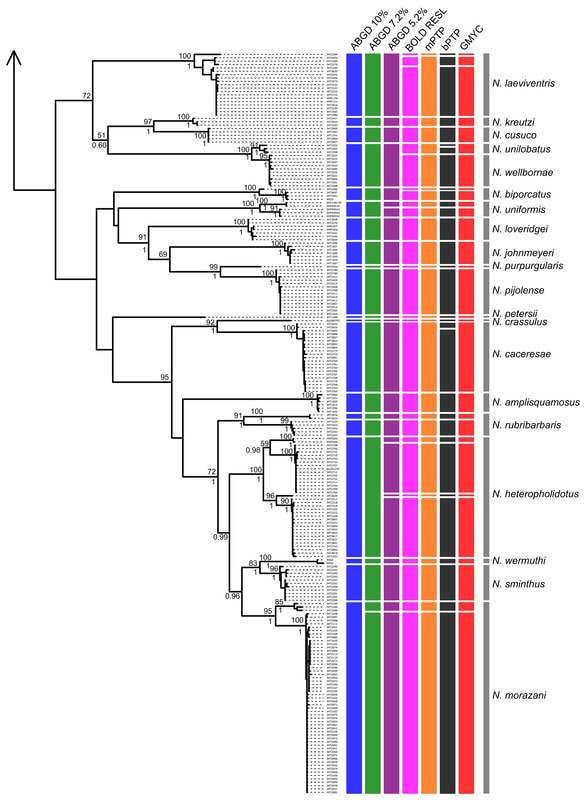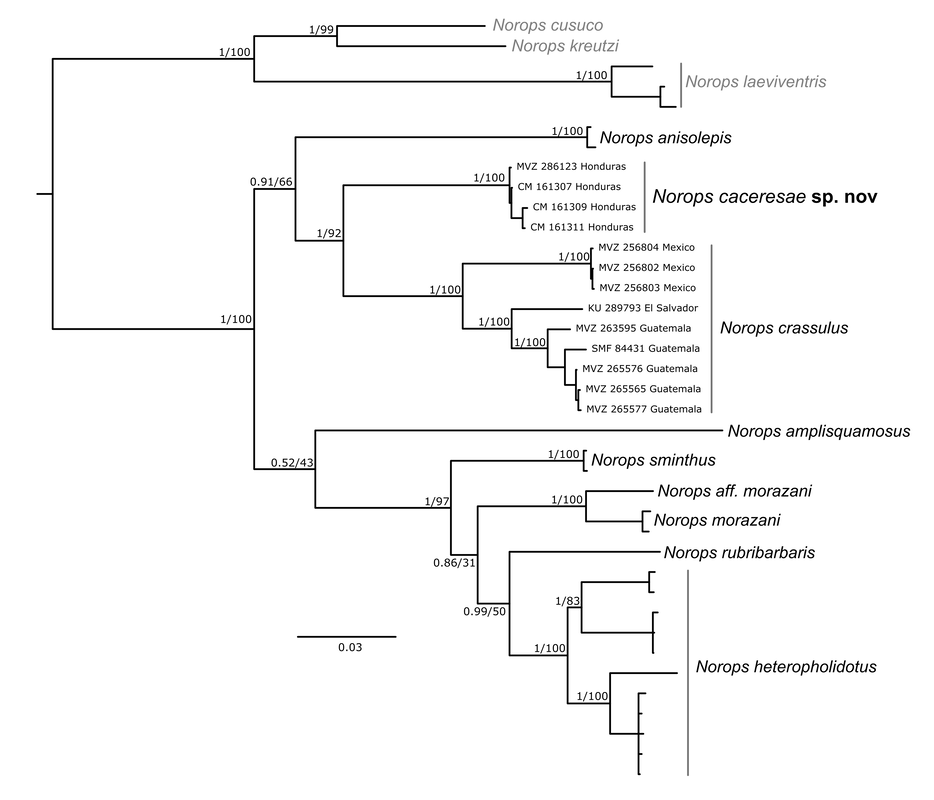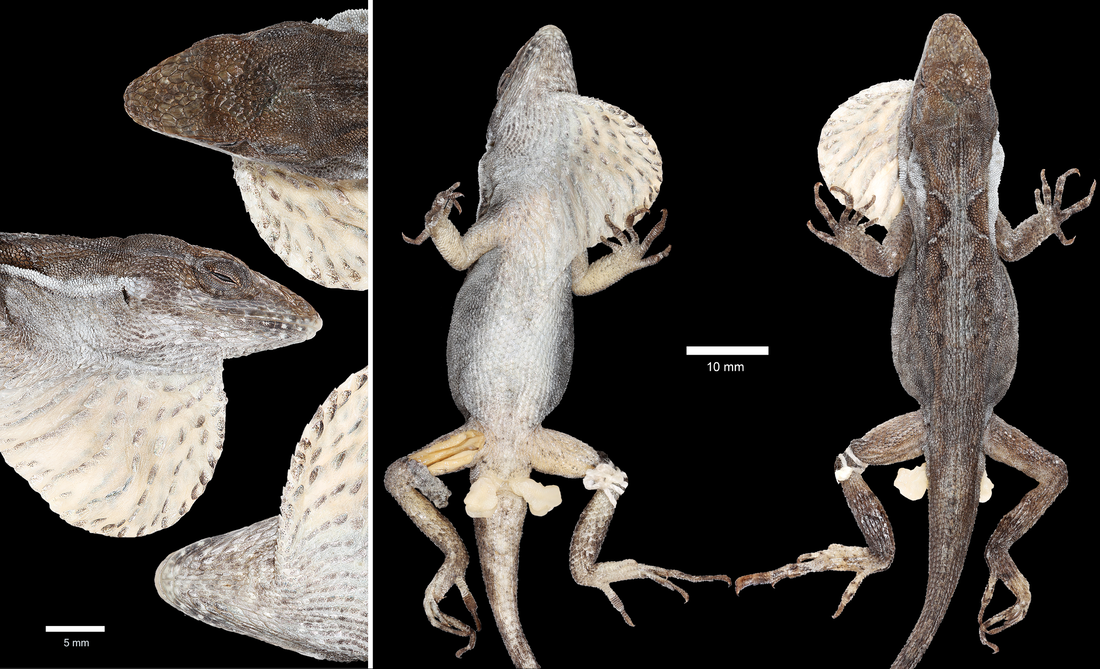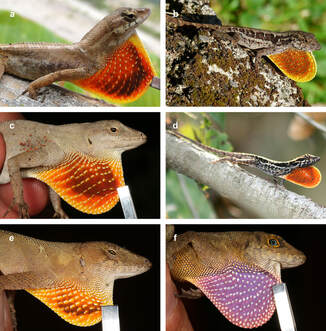Evolutionary Diversification and Taxonomy of
Anoles in Central America

Using DNA barcodes to reveal hidden diversity in Mesoamerican anoles
Hofmann, EP, KE Nicholson, IR Luque-Montes, G Köhler, C Cerrato-Mendoza, M Medina-Flores, LD Wilson, and JH Townsend. 2019. Cryptic diversity, but to what extent? Discordance between single-locus species delimitation methods within mainland anoles (Squamata: Dactyloidae) from Northern Central America. Frontiers in Genetics 10: 11 (1–13). Download here
In the third major paper from his MS thesis work, Erich Hofmann led a comprehensive examination of species-level diversity among Chortis Block anoles using a comparative set of DNA barcode-based species delimitation methods, which we recently published in the journal Frontiers In Genetics. In this paper, we explore diversity of mainland species of anole lizards from the Chortís Block biogeographical province of northern Central America using a DNA barcoding approach, generating and analyzing cytochrome oxidase subunit I (COI) sequences for over 400 samples assignable to 33 of 38 (86.8%) native and one introduced mainland species. We subsequently tested the effects different models of nucleotide substitution, different species-delimitation algorithms, and reducing our dataset had on species delimitation estimates. We used two distance-based (ABGD, RESL) and three tree-based (bPTP, mPTP, GMYC) analyses on both the full dataset and a dataset consisting only of unique halotypes.
From 34 nominal taxa, analyses of the full dataset recovered between 34 and 64 operational taxonomic units (OTUs), while analyses of the reduced dataset inferred between 36 and 59. Reassigning individuals to either mPTP-inferred or ABGD clustered (7.2% threshold) groups improved the detection of a barcoding gap across three different models of nucleotide substitution, removing overlap between intra- and interspecific distances. Our results highlight the underestimated diversity of mainland Chortís Block anoles, but the lack of congruence between analyses demonstrates the importance of considering multiple analytical methods when dealing with single-locus datasets. We recommend future studies consider the effects of different models of nucleotide substitution on proposed barcoding gaps, as well as the effect reducing a dataset to unique haplotypes may have on proposed diversity estimates.
Hofmann, EP, KE Nicholson, IR Luque-Montes, G Köhler, C Cerrato-Mendoza, M Medina-Flores, LD Wilson, and JH Townsend. 2019. Cryptic diversity, but to what extent? Discordance between single-locus species delimitation methods within mainland anoles (Squamata: Dactyloidae) from Northern Central America. Frontiers in Genetics 10: 11 (1–13). Download here
In the third major paper from his MS thesis work, Erich Hofmann led a comprehensive examination of species-level diversity among Chortis Block anoles using a comparative set of DNA barcode-based species delimitation methods, which we recently published in the journal Frontiers In Genetics. In this paper, we explore diversity of mainland species of anole lizards from the Chortís Block biogeographical province of northern Central America using a DNA barcoding approach, generating and analyzing cytochrome oxidase subunit I (COI) sequences for over 400 samples assignable to 33 of 38 (86.8%) native and one introduced mainland species. We subsequently tested the effects different models of nucleotide substitution, different species-delimitation algorithms, and reducing our dataset had on species delimitation estimates. We used two distance-based (ABGD, RESL) and three tree-based (bPTP, mPTP, GMYC) analyses on both the full dataset and a dataset consisting only of unique halotypes.
From 34 nominal taxa, analyses of the full dataset recovered between 34 and 64 operational taxonomic units (OTUs), while analyses of the reduced dataset inferred between 36 and 59. Reassigning individuals to either mPTP-inferred or ABGD clustered (7.2% threshold) groups improved the detection of a barcoding gap across three different models of nucleotide substitution, removing overlap between intra- and interspecific distances. Our results highlight the underestimated diversity of mainland Chortís Block anoles, but the lack of congruence between analyses demonstrates the importance of considering multiple analytical methods when dealing with single-locus datasets. We recommend future studies consider the effects of different models of nucleotide substitution on proposed barcoding gaps, as well as the effect reducing a dataset to unique haplotypes may have on proposed diversity estimates.

Origins and biogeography of the Anolis crassulus subgroup (Squamata: Dactyloidae) in the highlands of Nuclear Central America
Hofmann, EP, and JH Townsend. 2017. Origins and biogeography of the Anolis crassulus subgroup (Squamata: Dactyloidae) in the highlands of Nuclear Central America. BMC Evolutionary Biology 17: 267. Download here
A portion of the thesis work completed by Townsend Lab alumni Erich Hofmann has been published in the journal BMC Evolutionary Biology, and is available for free download here: http://rdcu.be/C2pY. This paper brings some long-awaited clarity to the Anolis crassulus subgroup, a clade of lizards that has long frustrated taxonomists (see quotes below), and, among other things, reveals the following:
Hofmann, EP, and JH Townsend. 2017. Origins and biogeography of the Anolis crassulus subgroup (Squamata: Dactyloidae) in the highlands of Nuclear Central America. BMC Evolutionary Biology 17: 267. Download here
A portion of the thesis work completed by Townsend Lab alumni Erich Hofmann has been published in the journal BMC Evolutionary Biology, and is available for free download here: http://rdcu.be/C2pY. This paper brings some long-awaited clarity to the Anolis crassulus subgroup, a clade of lizards that has long frustrated taxonomists (see quotes below), and, among other things, reveals the following:
- Populations of lizards called Anolis (Norops) crassulus from Intibuca, La Paz, and Lempira represent a new species.
- The Honduran lineage of Anolis crassulus diverged from other lineages approximately 13 million years ago.
- Cladogenesis in the A. crassulus subgroup began approximately 22 million years ago, with the common ancestor originating in the Chortis Block.
- Recognition of the species Anolis heteropholidotus, A. morazani, A. rubribarbaris, A. sminthus, and A. wermuthi is supported.
- Anolis heteropholidotus contains at least four allopatric mitochondrial lineages.
- Cryptic, allopatric lineages were uncovered that are sister lineages to A. morazani (in the Sierra de Agalta) and A. rubribarbaris (in the Guajiquiro region of La Paz).
- John R. Meyer & Larry D. Wilson (1971): “The inter-relationships of the populations… [of the crassulus group] are exceedingly complex, and… we are unable to suggest a satisfactory arrangement.”
- Carl S. Lieb (1981): “The resolution of the tremendous taxonomic problems raised by the schiedei [sic] species group, together with… the Anolis crassulus radiation is probably the most important single problem facing Anolis systematics.”
- James R. McCranie, Larry D. Wilson, & Kenneth L. Williams (1992): “Clearly, a thorough analysis of crassulus-like specimens from throughout their range from western Chiapas to northern El Salvador and southwestern Honduras is sorely needed.”
- James R. McCranie & Gunther Köhler (2015): “…a study of the N. crassulus-like populations with strongly keeled ventral scales from throughout their range from western Chiapas, Mexico, to northwestern El Salvador and southwestern and central Honduras is needed.”

A cryptic new species of anole (Squamata: Dactyloidae), previously referred to as Anolis crassulus Cope, 1864, from the Lenca Highlands of Honduras
Hofmann, EP, and JH Townsend. 2018. A cryptic new species of anole (Squamata: Dactyloidae), previously referred to as Anolis crassulus Cope, 1864, from the Lenca Highlands of Honduras. Annals of the Carnegie Museum 85(2): 91–111. Download here
In the second major paper resulting from his award-winning thesis research, Erich Hofmann led a study to delimit a new species of anole from the Lenca Highlands region of Honduras, which we named Norops caceresae, in honor of the late Berta Caceres. The article appeared in the Annals of the Carnegie Museum and follows up on our paper in BMC Evolutionary Biology, which showed the molecular and biogeographic justification for recognizing the new species, by presenting a comprehensive examination of the morphology of crassulus-like anoles in Mesoamerica.
Berta's Anole (Norops caceresae) is endemic to the Lenca Highlands of Honduras, and we chose the name as a small token in honor and memory of Berta Isabel Cáceres Flores, a Lencan indigenous rights activist, founder of COPINH (Consejo Cívico de Organizaciones Populares e Indígenas de Honduras/National Council of Popular and Indigenous Organizations of Honduras), and winner of the Goldman Environmental Prize in 2015. She was assassinated in her home in March 2016 in retaliation for her successful effort to halt the building of the Agua Zarca dam on the sacred Rio Gualcarque in western Honduras. In November 2018, seven men were convicted as part of Cáceres's murder, and nine total have been arrested (including the former CEO of the firm behind the project to build the dam). Berta Cáceres is one of dozens of Honduran environmental and indigenous rights activists who have been murdered in retaliation for fighting against exploitation of indigenous peoples and natural resources. Please take the time to read about Berta and her activism at the links below.
https://www.goldmanprize.org/recipient/berta-caceres/
https://copinh.org/
http://bertacaceres.org/
https://en.wikipedia.org/wiki/Berta_C%C3%A1ceres
https://news.mongabay.com/…/7-convicted-of-killing-hondura…/
Hofmann, EP, and JH Townsend. 2018. A cryptic new species of anole (Squamata: Dactyloidae), previously referred to as Anolis crassulus Cope, 1864, from the Lenca Highlands of Honduras. Annals of the Carnegie Museum 85(2): 91–111. Download here
In the second major paper resulting from his award-winning thesis research, Erich Hofmann led a study to delimit a new species of anole from the Lenca Highlands region of Honduras, which we named Norops caceresae, in honor of the late Berta Caceres. The article appeared in the Annals of the Carnegie Museum and follows up on our paper in BMC Evolutionary Biology, which showed the molecular and biogeographic justification for recognizing the new species, by presenting a comprehensive examination of the morphology of crassulus-like anoles in Mesoamerica.
Berta's Anole (Norops caceresae) is endemic to the Lenca Highlands of Honduras, and we chose the name as a small token in honor and memory of Berta Isabel Cáceres Flores, a Lencan indigenous rights activist, founder of COPINH (Consejo Cívico de Organizaciones Populares e Indígenas de Honduras/National Council of Popular and Indigenous Organizations of Honduras), and winner of the Goldman Environmental Prize in 2015. She was assassinated in her home in March 2016 in retaliation for her successful effort to halt the building of the Agua Zarca dam on the sacred Rio Gualcarque in western Honduras. In November 2018, seven men were convicted as part of Cáceres's murder, and nine total have been arrested (including the former CEO of the firm behind the project to build the dam). Berta Cáceres is one of dozens of Honduran environmental and indigenous rights activists who have been murdered in retaliation for fighting against exploitation of indigenous peoples and natural resources. Please take the time to read about Berta and her activism at the links below.
https://www.goldmanprize.org/recipient/berta-caceres/
https://copinh.org/
http://bertacaceres.org/
https://en.wikipedia.org/wiki/Berta_C%C3%A1ceres
https://news.mongabay.com/…/7-convicted-of-killing-hondura…/

Two new species of Mesoamerican anoles named for pioneers of Honduran herpetology, Wilson and McCranie
Köhler, G, JH Townsend, and CBP Petersen 2016. Taxonomic revision of Norops tropidonotus (Peters 1863), with the resurrection of N. spilorhipus (Alvarez del Toro & Smith 1956) and description of two new species. Mesoamerican Herpetology 3(1): 8–41.
A new paper by Gunther Köhler, Joe Townsend, and Claus Bo P. Petersen presents a taxonomic revision of the widespread anole Norops tropidonotus, and presents evidence for the resurrection of N. spilorhipis (Álvarez del Toro and Smith, 1956) and the description of two new species: Norops mccraniei, a primarily pine-oak forest inhabitant endemic to the Chortis Block, and N. wilsoni, a lowland rainforest edge inhabitant endemic to the northern slopes of the Cordillera Nombre de Dios.
These two new species were named for Larry David Wilson and James Randy McCranie, the pioneering herpetologists that have worked to document the amphibians and reptiles of Honduras since 1967 and 1980, respectively. There combined work includes the description of over 100 endemic species, many of which are endemic to the country's cloud forests and offshore islands.
The paper was published in the open access journal Mesoamerican Herpetology, and is available for download here.
Köhler, G, JH Townsend, and CBP Petersen 2016. Taxonomic revision of Norops tropidonotus (Peters 1863), with the resurrection of N. spilorhipus (Alvarez del Toro & Smith 1956) and description of two new species. Mesoamerican Herpetology 3(1): 8–41.
A new paper by Gunther Köhler, Joe Townsend, and Claus Bo P. Petersen presents a taxonomic revision of the widespread anole Norops tropidonotus, and presents evidence for the resurrection of N. spilorhipis (Álvarez del Toro and Smith, 1956) and the description of two new species: Norops mccraniei, a primarily pine-oak forest inhabitant endemic to the Chortis Block, and N. wilsoni, a lowland rainforest edge inhabitant endemic to the northern slopes of the Cordillera Nombre de Dios.
These two new species were named for Larry David Wilson and James Randy McCranie, the pioneering herpetologists that have worked to document the amphibians and reptiles of Honduras since 1967 and 1980, respectively. There combined work includes the description of over 100 endemic species, many of which are endemic to the country's cloud forests and offshore islands.
The paper was published in the open access journal Mesoamerican Herpetology, and is available for download here.














